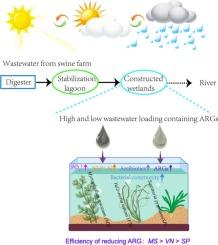Removal of Antibiotic Resistance from Wastewater in Aquatic Ecosystems Dominated by Submerged Macrophytes
IF 12.2
1区 环境科学与生态学
Q1 ENGINEERING, ENVIRONMENTAL
引用次数: 0
Abstract
Submerged macrophytes in constructed wetlands (CWs) can effectively improve wastewater quality. However, the effectiveness of different submerged macrophytes in removing antibiotic-resistant genes (ARGs) from wastewater remains unexplored. Additionally, wastewater loading in wetlands can fluctuate due to climate change, potentially affecting ARG removal efficiency. In this study, we systematically constructed microscale wetlands using three submerged plants: Vallisneria natans (VN), Sagittaria pygmaea (SP), and Myriophyllum spicatum (MS). Their effectiveness in ARGs removal was analyzed at hydraulic retention times (HRTs) of 0, 3, 6, and 9 days under high (HWL) and low (LWL) wastewater loading. The results indicated that under LWL conditions, all ecosystems exhibited a higher reduction rate of ARG diversity and relative abundance (RS) compared to HWL conditions. The efficiency of all ecosystems in reducing ARG diversity and abundance followed the order: MS > VN > SP. The sul resistance gene exhibited the highest RS and was degraded most rapidly in all samples. Additionally, sulfadimidine concentrations significantly decreased under LWL conditions, which was significantly correlated with sul reduction. Chemical oxygen demand, total phosphorus, total nitrogen, ammonium nitrogen, and nitrate nitrogen were identified as key factors influencing bacterial and ARG profiles. The increase in rhizobial bacteria and decrease in aerobic denitrifying bacteria likely contributed significantly to ARGs removal. This study offers new insights into ARG removal by submerged macrophytes in CWs, emphasizing the role of wastewater loading and the potential of MS in enhancing ARG degradation. These findings enhance CW design and management to mitigate ARG contamination in wastewater.

求助全文
约1分钟内获得全文
求助全文
来源期刊

Journal of Hazardous Materials
工程技术-工程:环境
CiteScore
25.40
自引率
5.90%
发文量
3059
审稿时长
58 days
期刊介绍:
The Journal of Hazardous Materials serves as a global platform for promoting cutting-edge research in the field of Environmental Science and Engineering. Our publication features a wide range of articles, including full-length research papers, review articles, and perspectives, with the aim of enhancing our understanding of the dangers and risks associated with various materials concerning public health and the environment. It is important to note that the term "environmental contaminants" refers specifically to substances that pose hazardous effects through contamination, while excluding those that do not have such impacts on the environment or human health. Moreover, we emphasize the distinction between wastes and hazardous materials in order to provide further clarity on the scope of the journal. We have a keen interest in exploring specific compounds and microbial agents that have adverse effects on the environment.
 求助内容:
求助内容: 应助结果提醒方式:
应助结果提醒方式:


